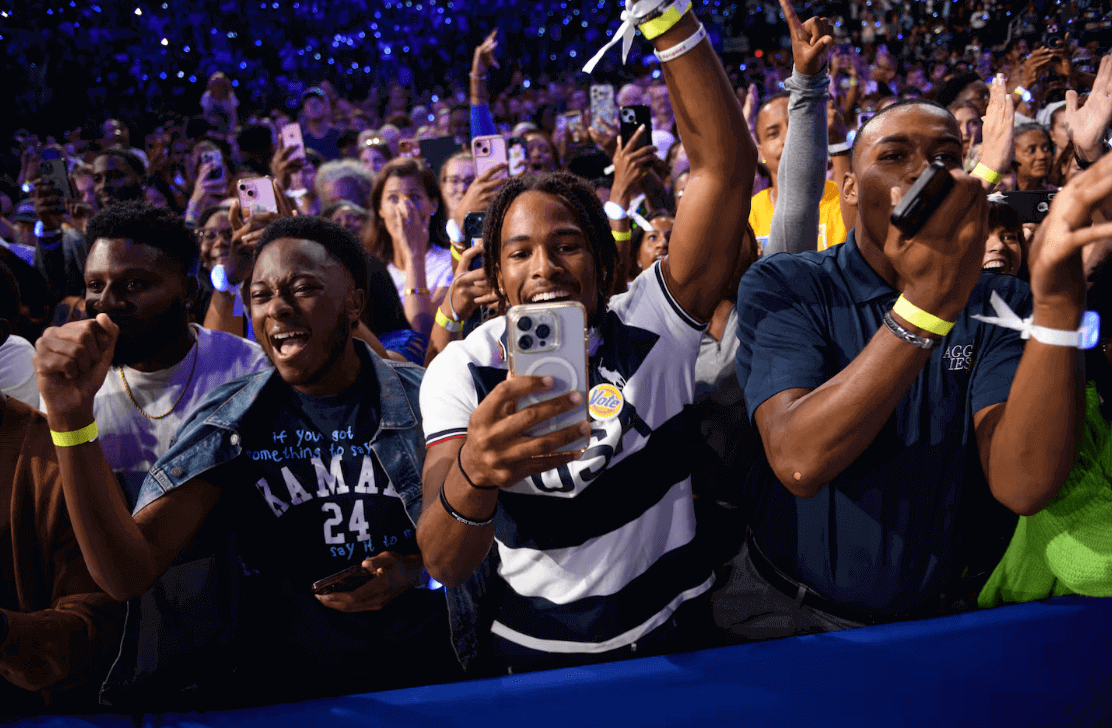哈里斯和特朗普将筹码押在不同州以赢得白宫

【中美创新时报2024 年 9 月 15 日编译讯】(记者温友平编译)根据 AdImpact 追踪的电视、广播和数字平台上已经播放的广告的支出和预订情况数据显示,特朗普和哈里斯阵营在他们将投放广告的七个主要州和他们已经雇用员工的几个州基本达成一致。但双方部署了截然不同的作战计划。《华盛顿邮报》记者迈克尔·谢勒对此作了下述报道。
民主党在过去一年里一直在关注熟悉的三个北方州,它们将在 11 月入主白宫:威斯康星州、密歇根州和宾夕法尼亚州是通往胜利的“最清晰的途径”,副总统卡马拉·哈里斯的竞选领导人在 7 月写道——只要她也在奥马哈地区获得一张选举人票。
与此同时,特朗普团队一直专注于东部时区的自己的道路,这是一个名副其实的“红墙”三重奏,与五大湖周围的北部“蓝墙”重叠。
“只要我们守住北卡罗来纳州,我们只需要赢得佐治亚州和宾夕法尼亚州,”特朗普竞选官员上个月在战略简报中告诉记者。 “这就是我们获胜所需要的一切。所以当每个人都在忙着想方设法时,她仍然在防守。”
根据 AdImpact 的数据,不同的策略都取决于在宾夕法尼亚州的胜利,这反映在两个竞选团队和支持他们的超级政治行动委员会的广告支出中。AdImpact 追踪了电视、广播和数字平台上已经播放的广告的支出和预订情况。数据显示,特朗普和哈里斯阵营在他们将投放广告的七个主要州和他们已经雇用员工的几个州基本达成一致。但双方部署了截然不同的作战计划。
例如,共和党在 3 月 12 日至 9 月 3 日期间将 19% 的广告费花在了佐治亚州的总统竞选上,而民主党只花了 11%。民主党将 16% 的支出集中在密歇根州,而共和党的支出为 12%。
与此同时,共和党将更多的筹码投入了宾夕法尼亚州,鉴于该州的规模,如果结果接近,该州很可能掌握选举的关键。该州占据了共和党 36% 的广告支出,而民主党只占 21%。
“宾夕法尼亚和佐治亚州已成为本次选举最后阶段的中心,”共和党战略家约翰·阿什布鲁克 (John Ashbrook) 表示。“没有佐治亚州,共和党几乎不可能获胜,而没有宾夕法尼亚州,民主党也几乎不可能获胜。”
秋季选举人团棋局是 18 世纪开国元勋对多数人统治的担忧的遗留,在总统竞选后期总会产生复杂的博弈。但今年的选举人团棋局规模创历史新小,关键州的差距预计很小,每位候选人获胜的各种途径似乎更加有限。
两大政党的竞选团队仍在明尼苏达州、弗吉尼亚州和新罕布什尔州等州派驻工作人员,哈里斯于 9 月 4 日访问了这些州。但两大竞选团队都将资金投入范围集中在亚利桑那州、乔治亚州、密歇根州、内华达州、北卡罗来纳州、宾夕法尼亚州和威斯康星州这七个州以及内布拉斯加州第二国会选区。
在这一核心战场内,特朗普团队确定了一个名为“目标可说服者”的选民群体,该群体约占投票池的 11%,是他们大部分资金投入的重点。特朗普协调竞选活动中的另一个项目重点是争取那些倾向于共和党但不确定是否会去投票站投票或投出选票的选民。
哈里斯的竞选团队筹集和花费了更多资金,他们有一个更雄心勃勃的选民沟通计划,更多的资金流向更多的州,并且更加依赖不针对特定州的全国性广告购买。哈里斯一方花费的资金中有 18% 用于全国范围,而特朗普一方只有 8%。
哈里斯的总体业务规模也大得多。总体而言,截至 9 月 3 日,民主党一方已花费或预留了至少 9.33 亿美元的广告费用,而共和党一方为 4.85 亿美元。这一差距可能会在未来几周内缩小,因为 AdImpact 跟踪的共和党人在进行未来广告预订方面不如民主党人积极。
但哈里斯竞选团队并没有试图掩盖这样一个事实,即他们的计划在地理上比共和党对手更为广泛。
“我们的竞选策略依赖于广泛的地图:特朗普全力押注一到两个‘必须赢’的州。我们没有那种奢侈。每个战场州都很接近,所以我们需要在每个州积极竞争,以建立获得 270 张选举人票的道路,”哈里斯竞选主席 Jen O’Malley Dillon 在 9 月 7 日致顶级捐赠者的备忘录中说道。
根据 AdImpact 的数据,包括独立团体在内的哈里斯竞选团队已将其约 13% 的州级广告资源投入亚利桑那州和内华达州,而特朗普竞选团队和联盟团体的这一比例约为 9%。哈里斯在这两个州的胜利将弥补在威斯康星州或密歇根州的失利,如果她赢得宾夕法尼亚州,她将获得选举人团胜利。
哈里斯面临的挑战是,如果她保住了密歇根州和威斯康星州,但失去了宾夕法尼亚州的 19 张选举人票,她将需要赢得北卡罗来纳州或佐治亚州以及两个西部州之一来弥补差距。
支持哈里斯的主要团体之一美国桥梁 21 世纪(American Bridge 21st Century)迄今已花费或预留了 4400 万美元,已决定将所有支出集中在威斯康星州、宾夕法尼亚州和密歇根州。另一个主要的民主党超级政治行动委员会未来前进(Future Forward)已将其支出分散到所有战场,包括内布拉斯加州的奥马哈媒体市场。
在共和党方面,两个最大的广告超级政治行动委员会大致划分了各州,宾夕法尼亚州有明显的重叠。由赌场大亨米里亚姆·阿德尔森(Miriam Adelson)支持的保护美国政治行动委员会专注于密歇根州、威斯康星州和宾夕法尼亚州,而 MAGA Inc. 则专注于佐治亚州、亚利桑那州、内华达州和宾夕法尼亚州。
北卡罗来纳州最近的民意调查显示,竞争非常激烈,在昆尼皮亚克大学 9 月初的一项调查中,哈里斯在潜在选民中领先 3 个百分点。这引起了共和党战略家对他们东部“红墙”完整性的担忧。民主党战略家继续认为佐治亚州比北卡罗来纳州更有利,部分原因是该州黑人选民比例更高。
在哈里斯本周的辩论中表现出色后,特朗普的共和党盟友不再谈论他们今年夏天看到的可能横扫全场的局面,当时总统乔·拜登在民调中一落千丈。前众议院议长凯文·麦卡锡周三表示,选民应该关注特朗普连任的最强堡垒,这与特朗普竞选团队的早期宣传如出一辙。
麦卡锡在 CNBC 上表示:“最终取决于两个州——宾夕法尼亚州和佐治亚州。”“如果特朗普像以前一样获胜,赢得宾夕法尼亚州和佐治亚州,他的得票率将达到 270。他不需要亚利桑那州。他不需要内华达州。”
题图:周四,北卡罗来纳州格林斯博罗副总统卡马拉·哈里斯的竞选集会上的人群。梅丽莎·苏·格里茨/华盛顿邮报
附原英文报道:
Harris and Trump place their chips on different states to win White House
By Michael Scherer The Washington Post,Updated September 14, 2024
The crowd at a campaign rally for Vice President Kamala Harris in Greensboro, N.C., on Thursday.Melissa Sue Gerrits/For The Washington Post
Democrats have spent the last year eyeing a familiar trio of northern states that would deliver the White House in November: Wisconsin, Michigan and Pennsylvania are the “clearest pathway” to victory, Vice President Kamala Harris’s campaign leaders wrote in July – as long as she also picks up a single electoral vote in the Omaha area.
The Trump team, meanwhile, has been focused on its own path in the Eastern time zone, a veritable “Red Wall” trifecta that overlaps with the northern “Blue Wall” around the Great Lakes.
“As long as we hold North Carolina, we just need to win Georgia and Pennsylvania,” a Trump campaign official told reporters last month in a strategy briefing. “That is all we need to win. So when everybody is running around with all the machinations, she’s still playing defense.”
The different strategies, which both hinge on a win in Pennsylvania, have been reflected in ad spending by both campaigns and the super PACs supporting them, according to AdImpact, which tracks spending and reservations on television, radio and digital platforms for ads that have already run. The data shows that the Trump and Harris camps largely agree on the seven principal states where they will advertise and the several more where they have hired staff. But the two sides have deployed decidedly different battle plans.
Republicans, for instance, have spent 19 percent of their ad money between March 12 and Sept. 3 in the presidential contest in Georgia, compared with the 11 percent Democrats have spent. Democrats have focused 16 percent of their spending in Michigan, compared with 12 percent of the Republican spending.
Republicans, meanwhile, have moved a greater share of their chips into Pennsylvania, which given its size is likely to hold the key to the election if the outcome is close. That state has seen 36 percent of Republican ad dollars, compared with 21 percent for the Democratic side.
“Pennsylvania and Georgia have taken center stage for the final act of this election,” said John Ashbrook, a Republican strategist. “The map becomes nearly impossible for Republicans without Georgia, and it becomes nearly impossible for Democrats without Pennsylvania.”
The fall electoral college chess game, a vestige of 18th-century concerns that the Founding Fathers had about majority rule, always produces complex gamesmanship late in presidential contests. But this year the map is historically small, the margins in the key states are expected to be tiny, and the various paths each candidate has to victory appear more limited.
Both major-party campaigns continue to have staff in states such as Minnesota, Virginia and New Hampshire, where Harris made a visit Sept. 4. But both campaigns have focused their spending on a smaller footprint of just seven states – Arizona, Georgia, Michigan, Nevada, North Carolina, Pennsylvania and Wisconsin – as well as Nebraska’s 2nd Congressional District.
Within that core battleground, the Trump team has identified a subset of voters, called “Target Persuadables,” that makes up about 11 percent of the voting pool and is the focus of much of their spending. A separate program within Trump’s coordinated campaign is focused on turning out voters who lean Republican but are not certain to get to the polls or turn in a ballot.
The Harris campaign – which has raised and spent much more money – has a more ambitious plan for voter communication, with more money going to more states and with a greater reliance on national advertising buys that do not target specific states. Eighteen percent of the money spent by the Harris side has been spent nationally, compared with 8 percent on the Trump side.
Harris also has a much bigger operation overall. On the whole, the Democratic side had spent or reserved at least $933 million for advertising as of Sept. 3, compared with $485 million on the GOP side. That spread could narrow over the coming weeks, because Republicans have been less aggressive than Democrats in making future ad reservations tracked by AdImpact.
But the Harris campaign has not tried to hide the fact that it has a more geographically expansive plan than its Republican counterpart.
“Our campaign strategy relies on a wide map: Trump is all in on one to two ‘must win’ states. We don’t have that luxury. Every single battleground state is close, so we need to compete aggressively in every state to build a pathway to 270 electoral votes,” Harris campaign chair Jen O’Malley Dillon said in a memo to top donors on Sept. 7.
The Harris effort, including independent groups, has put about 13 percent of its state-specific advertising resources into Arizona and Nevada, compared with about 9 percent for the Trump campaign and allied groups, according to AdImpact. A win in both those states for Harris would make up for a loss in either Wisconsin or Michigan, giving her an electoral college victory if she carried Pennsylvania.
The challenge Harris faces is that if she held Michigan and Wisconsin but lost Pennsylvania’s 19 electoral votes, she would need to win North Carolina or Georgia and one of the two Western states to make up the difference.
One of the major groups supporting Harris, American Bridge 21st Century – which has spent or reserved $44 million so far – has decided to focus all of its spending in Wisconsin, Pennsylvania and Michigan. Future Forward, the other major Democratic super PAC, has spread its spending across all the battlegrounds, including the Omaha media market in Nebraska.
On the Republican side, the two largest advertising super PACs have roughly divided up the states, with a notable overlap in Pennsylvania. Preserve America PAC, backed by casino magnate Miriam Adelson, has focused on Michigan, Wisconsin and Pennsylvania, while MAGA Inc. has focused on Georgia, Arizona, Nevada and Pennsylvania.
Recent polls in North Carolina have shown a close race, with Harris leading in an early-September survey by Quinnipiac University by three points among likely voters. That has raised concerns among Republican strategists about the integrity of their eastern “Red Wall.” Democratic strategists continue to view Georgia as a more favorable state than North Carolina, in part because of its higher percentage of Black voters.
After Harris’s strong debate performance this week, Republican allies of Trump are no longer talking about the sweep they saw as a possibility this summer, when President Joe Biden was crashing in polling. Former House speaker Kevin McCarthy, echoing the Trump campaign’s early pitch, said Wednesday that voters should focus on the strongest bulwark for another Trump term.
“It comes down to two states – it’s Pennsylvania and Georgia,” McCarthy said on CNBC. “If Trump carries exactly what he did before, and he wins Pennsylvania and Georgia, he is at 270. He doesn’t need Arizona. He doesn’t need Nevada.

